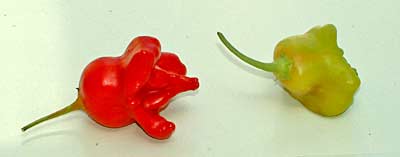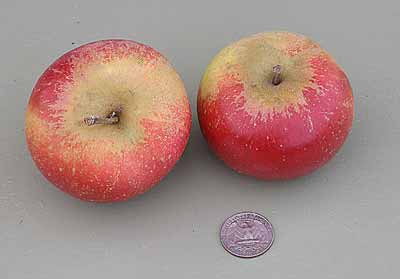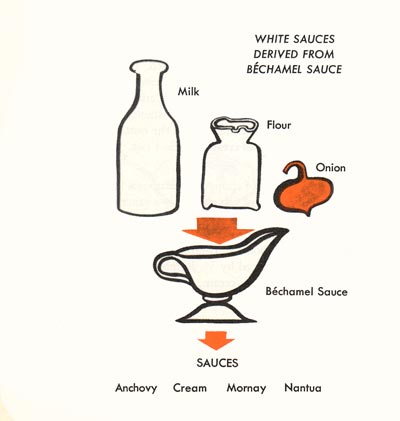
An almost flower-shaped, small variety of pepper which ripens from green to red, sometimes also called a Bishop's Crown. A variety of Capsicum baccatum.
A small to medium-sized, sweet, tart, pale yellow eating apple flushed and speckled with bright red. It is an old-fashioned apple introduced commercially in 1864 which does not keep well. It received the Royal Horticultural Society First Class Certificate in 1887. You have to catch it at just the right time for good flavour. It is an early-season apple, havested in mid-August in South-East England and with poor storage properties.

A variety of apple probably raised from a Blenheim Orange Seedling at Basset, Southampton, UK before 1850. Very similar to a Blenheim Orange.

A variety of sweet cooking apple which is russet yellow streaked with red and has been recorded since the 1790s. It was awarded the Royal Horticultural Society Award of Merit in 1901. It cooks to a pale yellow purée. This is a late-season variety, harvested from late September to early October in South-East England, is stored and is at its best between October and January, by which time it makes pleasant eating.
A fabricated cut of the beef primal rib. It is the first steak cut from the rib before the bone, or with the bone removed.
Beavers are still eaten in Germany. The only thing to be aware of is that the musk glands should be avoided during preparation of the beast or the meat will be spoiled.

Béchamel sauce is a white sauce made with flour, butter and milk usually flavoured with onion, bay, pepper and nutmeg. It may have added cream. It is one of the ‘mother’ sauces and the basis for others such as Mornay sauce and sauce Soubise. There is a version called sauce béchamel grasse where stock replaces the milk. Béchamel sauce is named after Louis de Béchamel, a politician and financier at the court of Louis XIV.
Barracuda. A large marine fish from the same family as grey mullet (US: striped mullet). Small versions grow to about 30 cm (12 inches) but it can grow as large as 120-150 cm (4-5 ft). It has large jaws, strong sharp teeth and a slender, streamlined body with small scales. The back is dark in colour, some brown, some greenish- and some bluish-grey, depending on the species, with a pale underbelly. It has firm white, well-flavoured flesh. Steaks can be grilled, fried or barbecued and then marinated, eaten hot or cold. Whole fish can be poached or baked. In American markets they are most likely to be Pacific or California barracuda.